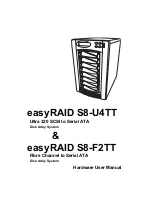
2
easyRAID S8
Serial ATA Disk Array Systems
1
O
ve
rv
iew –
Un
de
rs
ta
nd
in
g RAID
Understanding RAID
Read this section to understand how to balance data availability, access rate, and capacity man-
agement needs.
Just a Bunch Of Disks
Just a Bunch Of Disks (JBOD) consists of two or more disks that can be different sizes. Disk 1 is
completely filled, then disk 2, disk 3, and so on until the final disk is full.
The total capacity of JBOD is the sum of the capacities of each disk. Disks are added until the
desired total capacity is reached.
JBOD is used in the following situations:
• Building useful capacity from disks that are too small to be individually useful
• Making capacity management easier, since the user only sees one logical disk
JBOD doesn’t improve data availability or access rate when compared with a single disk.
RAID Levels
The overall arrangement of disks in RAID is called the RAID level. Read this section to under-
stand RAID levels.
RAID 0
In RAID 0, data is divided into pieces and written to all disks in parallel. This process is called
striping because the pieces of data form a stripe across multiple disks. This improves access rate,
but makes availability lower, since there are more disks and failure of a single disk causes failure
of the array. A RAID 0 array is unsuitable for data that can not easily be reproduced, or for data
that must be available for critical system operation.
RAID 0 consists of two or more disks of equal capacity. The total capacity of RAID 0 is the sum
of the capacities of each disk. Disks are added until the desired total capacity is reached.











































